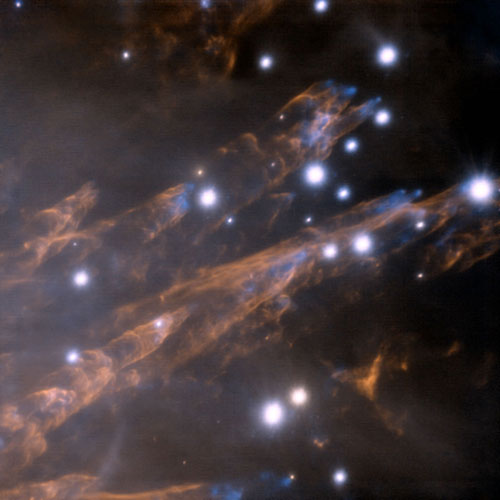
Astronomers just got their most detailed look yet at supersonic "bullets" of gas piercing through dense clouds of hydrogen gas in the Orion Nebula.
Each bullet [image] is about ten times the size of Pluto's orbit around the Sun and travels through the clouds at up to 250 miles (400 kilometers) per second-or about a thousand times faster than the speed of sound.
The bulk of both the bullets and the surrounding gas cloud [image] consists of molecular hydrogen. The tip of each bullet is packed with iron atoms that are heated by friction and glow bright blue in the new image, taken by the Gemini Observatory in Hawaii.
As the bullets plow through the clouds, they leave behind tubular orange wakes, each about a fifth of a light-year long. A light-year is the distance light travels in a year, about 6 trillion miles (10 trillion kilometers).
The Orion Nebula is a young stellar nursery located about 1,500 light-years away. Scientists think our Sun was born in a similar environment some 4.5 billion years ago.
The Orion bullets were first spotted in a visible-light image in 1983, and followed up by infrared observations in 1992. Astronomers think the enormous clumps of gas were ejected from deep within the nebula following some unknown violent event about a thousand years ago.
"What I find stunning about the new image is the detail it shows, which was blurred out in any previous studies," said Michael Burton of the University of New South Wales, one of the scientists who first suggested the origin of the bullets 15 years ago.
Breaking space news, the latest updates on rocket launches, skywatching events and more!
"This level of precision will allow the evolution of the system to be followed over the next few years, for small changes in the structures are expected from year to year as the bullets continue their outward motion," Burton said.
The latest image of the Orion bullets was created with a new technology, called adaptive optics, which uses a laser guide star as a reference and a rapidly deforming mirror to correct image distortions from the Earth's atmosphere in real time.
- Top 10 Star Mysteries
- Space 'Slinky' Confirms Theory with a Twist
- Space Tornado! Cosmic Front Packs a Punch
- The Splendor of Orion: A Star Factory Unveiled
- Skulls, Tornadoes and Insects - The Bizarre Sightings of Modern Astronomy
- Top 10 Strangest Things in Space
Ker Than is a science writer and children's book author who joined Space.com as a Staff Writer from 2005 to 2007. Ker covered astronomy and human spaceflight while at Space.com, including space shuttle launches, and has authored three science books for kids about earthquakes, stars and black holes. Ker's work has also appeared in National Geographic, Nature News, New Scientist and Sky & Telescope, among others. He earned a bachelor's degree in biology from UC Irvine and a master's degree in science journalism from New York University. Ker is currently the Director of Science Communications at Stanford University.
